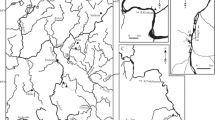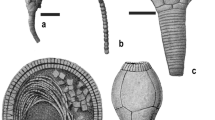Summary
Kahl's data on courtship behavior in the Ciconiidae were recoded and analyzed from a phenetic viewpoint. The results reflect his published classification except for the placement ofCiconia nigra and the generaJabiru andEphippiorhynchus. Similarities based on skeletal morphology are highly congruent with those recalculated from the behavioral data. The classification suggested by both sets of data is similar to that proposed byKahl with the following changes: (1)Jabiru is included withEphippiorhynchus; (2)Ephippiorhynchus is transferred into the Ciconiini.
Zusammenfassung
Die DatenKahls über das Sexualverhalten der Ciconiidae wurden nach äußeren Merkmalen codiert und analysiert. Die Ergebnisse spiegeln seine publizierte Klassifikation wider, mit Ausnahme der Stellung vonCiconia nigra und der GeneraJabiru undEphippiorhynchus. Ähnlichkeiten der Skelettmorphologie stimmen mit dem Vergleich der Verhaltensdaten in hohem Maße überein. Die auf der Grundlage von beiden Datensätzen sich abzeichnende Klassifikation ist jener vonKahl sehr ähnlich mit Ausnahme der folgenden Änderungen:Jabiru ist mitEphippiorhynchus zusammenzufassen;Ephippiorhynchus wird in die Ciconiini eingegliedert.
Similar content being viewed by others
Literature
Atchley, W. R. (1978): Ratios, regression intercepts, and the scaling of data. Syst. Zool. 27: 78–83.
Kahl, M. P. (1966): Comparative ethology of the Ciconiidae. Part 1. The Marabou Stork,Leptoptilos crumeniferus (Lesson). Behavior 27: 76–106.
Ditto (1971): Social behavior and taxonomic relationships of the storks. Living Bird 10: 151–170.
Ditto (1972 a): A revision of the family Ciconiidae (Aves). J. Zool. 167: 451–461.
Ditto (1972 b): Comparative ethology of the Ciconiidae. Part 2. The adjutant storks,Leptoptilos dubius (Gmelin) andL. javanicus (Horsfield). Ardea 60: 97–111.
Ditto (1972 c): Comparative ethology of the Ciconiidae. The woodstorks (generaMycteria andIbis). Ibis 114: 15–29.
Ditto (1972 d): Comparative ethology of the Ciconiidae. Part 4. The „typical“ storks (generaCiconia, Sphenorhynchus, Dissoura, andEuxenura). Z. Tierpsychol. 30: 225–252.
Ditto (1972 e): Comparative ethology of the Ciconiidae. Part 5. The openbill storks (genusAnastomus). J. Orn. 113: 121–137.
Ditto (1973): Comparative ethology of the Ciconiidae. Part 6. The Blacknecked, Saddlebill, and Jabiru storks (generaXenorhynchus, Ephippiorhynchus, andJabiru). Condor 75: 17–27.
Ditto (1979): Family Ciconiidae. Pp 245–252,in Check-list of birds of the world (E. Mayr &G. W. Cottrell, eds.), Mus. Comp. Zool., Cambridge, Massachusetts, 2nd ed., vol 1: xvii + 1–547.
Katz, J. C., &F. J. Rohlf (1974): Functionplane — A new approach to simple structure rotation. Psychometrika 39: 37–51.
Olson, S. L. (1978): Multiple origins of the Ciconiiformes. Proc. Colonial Waterbird Group 1978: 165–170.
Parkes, K. C. (1978): A review of the classification of the Ciconiiformes.In A. Sprunt, J. C. Ogden, &S. Winckler, eds. Wading birds. Natl. Audubon Soc. Res. Rep. no. 7: 7–15.
Peters, J. L. (1931): Check-list of birds of the world. Harvard Univ. Press, Cambridge, Mass. vol. 1: xviii + 1–345.
Rohlf, F. J. (1970): Linear adaptive hierarchical clustering schemes. Syst. Zool. 19: 58–82.
Ditto (1981): Consensus indices for comparing classifications. Math. Biosci. 59: 131–144.
Ditto &R. R. Sokal (1981): Comparing numerical taxonomic studies. Syst. Zool. 30: 459–490.
Sneath, P.H. A., &R. R. Sokal (1973): Numerical taxonomy. W. H. Freeman & Co., San Francisco. 573 pp.
Verheyen, R. (1959): Contribution à l'anatomie et à la systematique de base des Ciconiiformes (Parker 1868). Bull. Inst. Roy Soc. Natur. Belg. 35: 1–34.
Wetmore, A. (1960): A classification for the birds of the world. Smithsonian Misc. Coll. 139: 1–37.
Wood, D. S. (1982): A phenetic assessment of the Ciconiidae (Aves) using skeletal morphology. Unpubl. Ph. D. Diss., Univ. Oklahoma, Norman.
Ditto (1983 a): Phenetic relationships within the Ciconiidae (Aves). Ann. Carnegie Mus. 52: 79–112.
Ditto (1983 b): Character transformations in phenetic studies using continuous morphometric variables. Syst. Zool. 32: 125–131.
Author information
Authors and Affiliations
Rights and permissions
About this article
Cite this article
Wood, D.S. Concordance between classifications of the Ciconiidae based on behavioral and morphological data. J Ornithol 125, 25–37 (1984). https://doi.org/10.1007/BF01652936
Published:
Issue Date:
DOI: https://doi.org/10.1007/BF01652936




